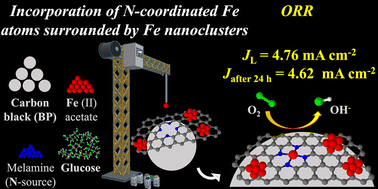Converting carbon black into an efficient and multi-site ORR electrocatalyst: the importance of bottom-up construction parameters†
Abstract
To boost efficient energy transitions, alternatives to expensive and unsustainable noble metal-based electrocatalysts for the oxygen reduction reaction (ORR) are needed. Having this in mind, carbon black – Black Pearls 2000 (BP) was enriched in active nitrogen-containing centers, including single-atom Fe–N sites surrounded by Fe nanoclusters, through a synthesis methodology employing only broadly available precursors. The methodical approach taken to optimize the synthesis conditions highlighted the importance of (1) a proper choice of the Fe precursor; (2) melamine as an N source to limit the formation of magnetite crystals and modulate the charge density nearby the active sites, and glucose to chelate/isolate Fe atoms and thus allow the Fe–N coordination to be established, with a limiting formation of Fe0 clusters; and (3) a careful dosing of the Fe load. The ORR on the optimized electrocatalyst (Fe0.06–N@BP) proceeds mostly through a four-electron pathway, having an onset potential (0.912 V vs. RHE) and limiting current density (4.757 mA cm−2) above those measured on Pt/C (0.882 V and 4.657 mA cm−2, respectively). Moreover, the current density yielded by Fe0.06–N@BP after 24 h at 0.4 V vs. RHE was still above that of Pt/C at t = 0 (4.44 mA cm−2), making it a promising alternative to noble metal-containing electrocatalysts in fuel cells.



 Please wait while we load your content...
Please wait while we load your content...